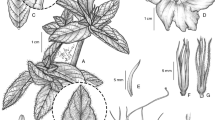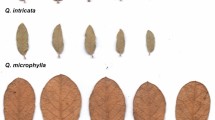Abstract
Multivariate analysis of both endocarp and leaf morphometrics is combined with cluster analysis and Bayesian inference of AFLP markers to assess the morphologic and genetic variation of five European members of Prunus section Prunus (P. cerasifera, P. domestica, P. insititia, P. spinosa, and P. × fruticans). Endocarp morphometrics separate most Prunus taxa studied, but overlap remains between P. domestica and P. cerasifera, and P. spinosa and P. × fruticans. Leaf morphometrics yield better separation of P. domestica and P. cerasifera, but do not allow distinction between P. spinosa and P. × fruticans. Both cluster analysis and PCoA of AFLP markers equally produce three distinct clusters. A first consists of all P. cerasifera samples and the sole P. cocomilia; a second cluster includes all individuals of P. domestica and P. insititia; and a third group comprises all P. spinosa and P. × fruticans samples.





Similar content being viewed by others
References
Aradhya MK, Weeks C, Simon CJ (2004) Molecular characterization of variability and relationships among seven cultivated and selected wild species of Prunus L. using amplified fragment length polymorphism. Scientia Horticulturae 103:131–144
Behre KE (1978) Formenkreise von Prunus domestica L. von der Wikingerzeit bis in die frühe Neuzeit nach Fruchtsteinen aus Haithabu und Alt-Schleswig. Berichte der Deutschen Botanischen Gesellschaft 91:161–179
Bortiri E, Oh S-H, Jiang J, Baggett S, Granger A, Weeks C, Buckingham M, Potter D, Parfitt DE (2001) Phylogeny and systematics of Prunus (Rosaceae) as determined by sequence analysis of ITS and the chloroplast trnL–trnF spacer DNA. Systematic Botany 26(4):797–807
Brewer MT, Lang L, Fujimura K, Dujmovic N, Gray S, van der Knaap E (2006) Development of a controlled vocabulary and software application to analyze fruit shape variation in tomato and other plant species. Plant Physiology 141:15–25
Coart E, Vekemans X, Smulders MJM, Wagner I, Van Huylenbroeck J, Van Bockstaele E, Roldán-Ruiz I (2003) Genetic variation in the endangered wild apple (Malus sylvestris (L.) Mill.) in Belgium as revealed by amplified fragment length polymorphism and microsatellite markers. Molecular Ecology 12:845–857
De Cock K, Vander Mijnsbrugge K, Breyne P, Van Bockstaele E, Van Slycken J (2008) Morphological and AFLP-based differentiation within the taxonomical complex section Caninae (subgenus Rosa). Annals of Botany 102(5):685–697
Decroocq V, Hagen LS, Favé M-G, Eyquard J-P, Pierronnet A (2004) Microsatellite markers in hexaploid Prunus domestica species and parentage lineage of three European plum cultivars using nuclear and chloroplast simple-sequence repeats. Molecular Breeding 13:135–142
Depypere L, Chaerle P, Vander Mijnsbrugge K, Goetghebeur P (2007) Stony endocarp dimension and shape variation in Prunus L. section Prunus. Annals of Botany 100:1585–1597
Dice LR (1945) Measures of the amount of ecologic association between species. Ecology 26:297–302
Drossou A, Katsiotis A, Leggett JM, Loukas M, Tsakas S (2004) Genome and species relationships in genus Avena based on RAPD and AFLP molecular markers. Theoretical and Applied Genetics 109:48–54
Fournier P (1977) Les Quatres Flores de la France. Lechevalier, Paris
Frary A, Doğanlar S (2003) Comparative genetics of crop plant domestication and evolution. Turk J Agric For 27:59–69
Gleason HA (1958) Illustrated flora, vol 2. Lancaster Press, Lancaster
Gower JC (1966) Some distance properties of latent root and vector methods used in multivariate analysis. Biometrika 53:325–338
Hagen LS, Khadari B, Lambert P, Audergon J-M (2002) Genetic diversity in apricot revealed by AFLP markers: species and cultivar comparisons. Theoretical and Applied Genetics 105:298–305
Hammer Ø, Harper DAT, Ryan PD (2001) PAST: paleontological statistics software package for education and data analysis. Palaeontologia Electronica 4(1):9 pp. http://palaeo-electronica.org/2001_1/past/issue1_01.htm
Hanelt P (1997) European wild relatives of Prunus fruit crops. Bocconea 7:401–408
Hübner S, Wissemann V (2004) Morphometrische Analysen zur Variabilität von Prunus spinosa L.—Populationen (Prunoideae, Rosaceae) im Mittleren Saaletal, Thüringen. Forum Geobotanicum 1:19–51
Jones CJ, Edwards KJ, Castaglione S, Winfield MO, Sala F, Van De Wiel C, Bredemeijer G, Vosman B, Matthes M, Daly A, Brettschneider R, Bettini P, Buiatti M, Maestri E, Malcevschi A, Marmiroli N, Aert R, Volckaert G, Rueda J, Linacero R, Vazquez A, Karp A (1997) Reproducibility testing of RAPD, AFLP and SSR markers in plants by a network of European laboratories. Molecular Breeding 3:381–390
Kalkman C (2004) Rosaceae. In: Kubitzki K (ed) The families and genera of vascular plants, vol VI. Springer, Berlin
Katayama H, Uematsu C (2005) Structural analysis of chloroplast DNA in Prunus (Rosaceae): evolution, genetic diversity and unequal mutations. Theoretical and Applied Genetics 111:1430–1439
Koopman WJM, Zevenbergen MJ, Van den Berg RG (2001) Species relationships in Lactuca s.l. (Lactuceae, Asteraceae) inferred from AFLP fingerprints. American Journal of Botany 88:1881–1887
Koopman WJM, Wissemann V, De Cock K, Van Huylenbroeck J, De Riek J, Sabatino GJH, Visser D, Vosman B, Ritz CM, Maes B, Werlemark G, Nybom H, Debener T, Linde M, Smulders MJM (2008) AFLP markers as a tool to reconstruct complex relationships: a case study in Rosa (Rosaceae). American Journal of Botany 95(3):353–366
Körber-Grohne U (1996) Pflaumen, Kirschpflaumen, Schlehen—Heutige Pflanzen und ihre Geschichte seit der Frühzeit. Thesis, Stuttgart
Krüssmann G (1978) Prunus. In: Handbuch der Laubgehölze, Band III. Verlag Paul Parey, Berlin, pp 13–56
Kühn F (1999) Alte Pflaumen, lebende Zeugen mittelalterlichen Obstbaus. Hamburger Werkstattreihe zur Archäologie 4:70–77
Lambinon J, De Langhe J-E, Delvosalle J, Duvigneaud J (1998) Flora van België, het Groothertogdom Luxemburg, Noord-Frankrijk en de aangrenzende gebieden (Pteridofyten en Spermatofyten), derde druk. Uitgave van de Nationale Plantentuin van België, Meise, pp 1091
Mabberley DJ (2008) Mabberley’s plant-book. A portable dictionary of plants, their classification and uses, 3rd edn. Cambridge University Press, Cambridge
Mace ES, Gebhardt CG, Lester RN (1999a) AFLP analysis of genetic relationships in the tribe Datureae (Solanaceae). Theoretical and Applied Genetics 99:634–641
Mace ES, Lester RN, Gebhardt CG (1999b) AFLP analysis of genetic relationships among the cultivated eggplant, Solanum melongena L., and wild relatives (Solanaceae). Theoretical and Applied Genetics 99:626–633
Maes N (1993) Genetische kwaliteit van inheemse bomen en struiken. Deelproject: Randvoorwaarden en knelpunten bij behoud en toepassing van inheems genenmateriaal. IBN-rapport 20, IKC-NBLF, IBN-DLO, Wageningen
Maes N, Rövekamp C (1998) Oorspronkelijk inheemse bomen en struiken in Vlaanderen. Een onderzoek naar autochtone genenbronnen in de Ecologische Impulsgebieden. Ministerie van de Vlaamse Gemeenschap, Afdeling Bos en Groen, Brussel
Maes B, Rövekamp C (1999) Cursus autochtone bomen en struiken Vlaanderen (een productie van het Ekologisch Adviesburo Maes en BRONNEN). Educatief bosbouwcentrum Groenendaal, Brussel
Maes N, Rövekamp C, Opstaele B, Zwaenepoel A (2003) Oorspronkelijke inheemse bomen en struiken in de houtvesterijen Antwerpen en Turnhout. Ministerie van de Vlaamse Gemeenschap, afdeling Bos en Groen, Brussel
Mantel NA (1967) The detection of disease clustering and a generalized regression approach. Cancer Research 27:209–220
Mason SC (1913) The pubescent-fruited species of Prunus of the Southwestern States. J Agr Res 1:147–179
McGregor CE, Lambert CA, Greyling MM, Louw JH, Warnich L (2000) A comparative assessment of DNA fingerprinting techniques (RAPD, ISSR, AFLP and SSR) in tetraploid potato (Solanum tuberosum L.) germplasm. Euphytica 113:135–144
Mowrey BD, Werner DJ (1990) Phylogenetic relationships among species of Prunus as inferred by isozyme markers. Theoretical and Applied Genetics 80:129–133
Nei M, Li WH (1979) Mathematical model for studying genetic variation in terms of restriction endonucleases. In: Proceedings of the National Academy of Sciences of the United States of America, vol 76, pp 5269–5273
Nielsen J, Olrik DC (2001) A morphometric analysis of Prunus spinosa, P. domestica ssp. insititia, and their putative hybrids in Denmark. Nordic Journal of Botany 21(4):349–363
Opstaele B (2001) Autochtone bomen en struiken in de houtvesterijen Leuven en Hasselt. Ministerie van de Vlaamse Gemeenschap, afdeling Bos en Groen, Brussel
Peyre P (1945) Les pruniers sauvages cultivés. Clermont-Ferrand, Paris
Rehder A (1940) Manual of cultivated trees and shrubs hardy in North America, 2nd edn. The Macmillan Company, New York
Reynders S, Salesses G (1991) Study of the genetic relationships within the subgenus Prunophora. Restriction maps of the ribosomal genes in P. cerasifera and P. spinosa. Acta Horticulturae 283:17–25
Ritz CM, Wissemann V (2003) Male correlated non-matroclinal character inheritance in reciprocal hybrids of Rosa section Caninae (DC.) Ser. (Rosaceae). Plant Systematics and Evolution 241:213–221
Röder K (1940) Sortenkundliche Untersuchungen an Prunus domestica. Kühn Archiv 54:1–132
Ronquist F, Huelsenbeck JP (2003) MRBAYES: Bayesian phylogenetic inference under mixed models. Bioinformatics 19:1572–1574
Rövekamp C, Maes N (2000) Oorspronkelijk inheemse bomen en struiken in het Regionaal Landschap West-Vlaamse Heuvels. Een onderzoek naar autochtone genenbronnen. Ministerie van de Vlaamse Gemeenschap, Afdeling Bos en Groen, Brussel
Rövekamp C, Maes N, Zwaenepoel A (2000) Oorspronkelijk inheemse bomen en struiken en cultuurwilgen in de Vlaamse Vallei. Een onderzoek naar autochtone genenbronnen in Gent en omgeving. Brussel, Ministerie van de Vlaamse Gemeenschap, Afdeling Bos en Groen
Russell JR, Fuller JD, Macaulay M, Hatz BG, Jahoor A, Powell W, Waugh R (1997) Direct comparison of levels of genetic variation among barley accessions detected by RFLPs, AFLPs, SSRs and RAPDs. Theoretical and Applied Genetics 95:714–722
Schenk MF, Thienpont C-N, Koopman WJM, Gilissen LJWJ, Smulders MJM (2008) Phylogenetic relationships in Betula (Betulaceae) based on AFLP markers. Tree Genetics and Genomes 4:911–924
Scholz H, Scholz I (1995) Prunoideae. In: Conert HJ, Jäger EJ, Kadereit JW, Schultze-Motel W, Wagenitz G, Weber HE (eds) Gustav Hegi’s Illustrierte Flora von Mitteleuropa, Band IV Teil 2B. Blackwell Wissenschafts-Verlag, Berlin, pp 446–510
Shaw J, Small RL (2004) Addressing the “hardest puzzle in American pomology:” Phylogeny of Prunus sect. Prunocerasus (Rosaceae) based on seven noncoding chloroplast DNA regions. American Journal of Botany 91:985–996
Shaw J, Small RL (2005) Chloroplast DNA phylogeny and phylogeography of the North American plums (Prunus subgenus Prunus section Prunocerasus, Rosaceae). American Journal of Botany 92:2011–2030
Sokal RR, Michener CD (1958) A statistical method for evaluating systematic relationships. University of Kansas Science Bulletin 28:1409–1438
Stace CA (1975) Hybridization and the Flora of the British Isles. Academic Press, London
Thórsson ÆT, Salmela E, Anamthawat-Jónsson K (2001) Morphological, cytogenetic, and molecular evidence for introgressive hybridization in birch. Journal of Heredity 92:404–408
Van de Peer Y, De Wachter R (1994) TREECON for Windows: a software package for the construction and drawing of evolutionary trees for the Microsoft Windows environment. Computer Applications in Biosciences 10:569–570
Van Droogenbroeck B, Breyne P, Goetghebeur P, Romeijn-Peeters E, Kyndt T, Gheysen G (2002) AFLP analysis of genetic relationships among papaya and its wild relatives (Caricaceae) from Ecuador. Theoretical and Applied Genetics 105:289–297
Van Zeist W, Woldring H (2000) Plum (Prunus domestica L.) varieties in late- and post-medieval Groningen: the archaeobotanical evidence. Palaeohistoria 39(40):563–576
Vos P, Hogers R, Bleeker M, Reijans M, van de Lee T, Hornes M, Frijters A, Pot J, Peleman J, Kuiper M, Zabeau M (1995) AFLP: a new technique for DNA fingerprinting. Nucleic Acids Research 23:4407–4414
Webb DA (1968) Prunus. In: Tutin TG, Heywood VH, Burges NA, Moore DM, Valentine DH, Walters SM, Webb DA (eds) Flora Europaea. Rosaceae to Umbelliferae, vol 2. Cambridge University Press, Cambridge
Werneck HL (1961) Die Wurzel- und Kernechten Stammformen der Pflaumen in Oberösterreich. Naturkundliches Jahrbuch der Stadt Linz
Wissemann V, Hellwig FH (1997) Reproduction and hybridisation in the genus Rosa, section Caninae (Ser.) Rehd. Botanica Acta 110:251–256
Woldring H (2000) On the origin of plums: a study of sloe, damson, cherry plum, domestic plums and their intermediates. Palaeohistoria 39(40):535–562
Zohary D (1992) Is the European plum, Prunus domestica L., a P. cerasifera Ehrh. × P. spinosa L. allo-polyploid? Euphytica 60:75–77
Zohary D, Hopf M (1994) Domestication of plants in the Old World, 2nd edn. Clarendon press, Oxford, p 279
Acknowledgments
Research funded by a PhD grant of the Institute for the Promotion of Innovation through science and Technology in Flanders (IWT-Vlaanderen). We are grateful to Stefaan Moreels and Leen Verschaeve for their assistance during sampling, Tine Paessens, Joel Dockx, Leen Verschaeve, David Halfmaerten, and Tina Kyndt for guidance with DNA isolation and/or AFLP analysis, Bert Maes for help with the plant identifications.
Author information
Authors and Affiliations
Corresponding author
Rights and permissions
About this article
Cite this article
Depypere, L., Chaerle, P., Breyne, P. et al. A combined morphometric and AFLP based diversity study challenges the taxonomy of the European members of the complex Prunus L. section Prunus . Plant Syst Evol 279, 219–231 (2009). https://doi.org/10.1007/s00606-009-0158-8
Received:
Accepted:
Published:
Issue Date:
DOI: https://doi.org/10.1007/s00606-009-0158-8




